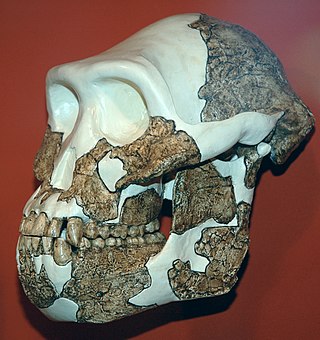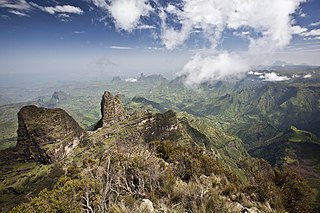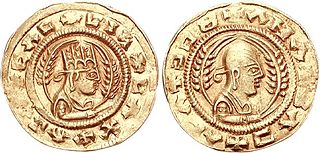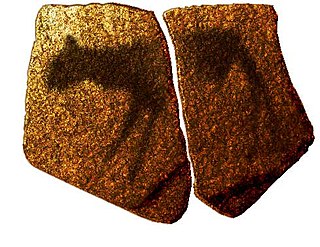
Australopithecus is a genus of early hominins that existed in Africa during the Pliocene and Early Pleistocene. The genera Homo, Paranthropus, and Kenyanthropus evolved from some Australopithecus species. Australopithecus is a member of the subtribe Australopithecina, which sometimes also includes Ardipithecus, though the term "australopithecine" is sometimes used to refer only to members of Australopithecus. Species include A. garhi, A. africanus, A. sediba, A. afarensis, A. anamensis, A. bahrelghazali and A. deyiremeda. Debate exists as to whether some Australopithecus species should be reclassified into new genera, or if Paranthropus and Kenyanthropus are synonymous with Australopithecus, in part because of the taxonomic inconsistency.

Axum, or Aksum, is a town in the Tigray Region of Ethiopia with a population of 66,900 residents. It is the site of the historic capital of the Aksumite Empire, a naval and trading power that ruled the whole region in addition parts of West Asia as Saudi Arabia, and Yemen. It ruled the region from about 400 BCE into the 10th century. Axum is located at the La’ilay Maychew district of Ethiopia.

The Oldowan was a widespread stone tool archaeological industry (style) in prehistory. These early tools were simple, usually made with one or a few flakes chipped off with another stone. Oldowan tools were used during the Lower Paleolithic period, 2.9 million years ago up until at least 1.7 million years ago (Ma), by ancient Hominins across much of Africa. This technological industry was followed by the more sophisticated Acheulean industry.

Australopithecus anamensis is a hominin species that lived approximately between 4.2 and 3.8 million years ago and is the oldest known Australopithecus species, living during the Plio-Pleistocene era.

The Awash is a major river of Ethiopia. Its course is entirely contained within the boundaries of Ethiopia and empties into a chain of interconnected lakes that begin with Lake Gargori and end with Lake Abbe on the border with Djibouti, some 100 kilometres from the head of the Gulf of Tadjoura. It is the principal stream of an endorheic drainage basin covering parts of the Amhara, Oromia and Somali Regions, as well as the southern half of the Afar Region.

The Bale Mountains are mountain ranges in the Oromia Region of southeast Ethiopia, south of the Awash River, part of the Ethiopian Highlands. They include Tullu Demtu, the second-highest mountain in Ethiopia, and Mount Batu. The Weyib River, a tributary of the Jubba River, rises in these mountains east of Goba. The Bale Mountains National Park covers 2,200 square kilometers of these mountains. The park's main attractions are the wild alpine scenery and the relative ease with which visitors can see unique birds and mammals.

The Ethiopian Highlands is a rugged mass of mountains in Ethiopia in Northeast Africa. It forms the largest continuous area of its elevation in the continent, with little of its surface falling below 1,500 m (4,900 ft), while the summits reach heights of up to 4,550 m (14,930 ft). It is sometimes called the Roof of Africa due to its height and large area. Most of the Ethiopian Highlands are part of central and northern Ethiopia, and its northernmost portion reaches into Eritrea.

Fa Hien Cave, also Pahiyangala Cave, is situated in the district of Kalutara, Western Province, Sri Lanka and according to a rural legend, named after an alleged resident during historical times, namely Buddhist monk Faxian. However, there is no archaeological or historical evidence to support this legend. Nonetheless, the site is of archaeological significance as Late Pleistocene human fossilized skeletal remains were discovered in the cave's sediments during excavations in the 1960s, the 1980s and in 2013. This is the largest natural stone cave in South Asia. 3500 people can stay here at the same time. To see the size of the cave, you have to go inside and look outside. Prehistoric humans have lived here for 35000-60000 years.They used sea fish, salt, and shark teeth as ornaments. This limestone was formed by corrosion over hundreds of thousands of years.

Eartham Pit is an internationally important archaeological site north-east of Boxgrove in West Sussex with findings that date to the Lower Palaeolithic. The oldest human remains in Britain have been discovered on the site, fossils of Homo heidelbergensis dating to 500,000 years ago. Boxgrove is also one of the oldest sites in Europe with direct evidence of hunting and butchering by early humans. Only part of the site is protected through designation, one area being a 9.8-hectare (24-acre) geological Site of Special Scientific Interest, as well as a Geological Conservation Review site.

Prehistoric Thailand may be traced back as far as 1,000,000 years ago from the fossils and stone tools found in northern and western Thailand. At an archaeological site in Lampang, northern Thailand Homo erectus fossils, Lampang Man, dating back 1,000,000 – 500,000 years, have been discovered. Stone tools have been widely found in Kanchanaburi, Ubon Ratchathani, Nakhon Si Thammarat, and Lopburi. Prehistoric cave paintings have also been found in these regions, dating back 10,000 years.
The year 2008 in archaeology
Balangoda Man refers to hominins from Sri Lanka's late Quaternary period. The term was initially coined to refer to anatomically modern Homo sapiens from sites near Balangoda that were responsible for the island's Mesolithic 'Balangoda Culture'. The earliest evidence of Balangoda Man from archaeological sequences at caves and other sites dates back to 38,000 BCE, and from excavated skeletal remains to 30,000 BC, which is also the earliest reliably dated record of anatomically modern humans in South Asia. Cultural remains discovered alongside the skeletal fragments include geometric microliths dating to 28,500 BC, which together with some sites in Africa is the earliest record of such stone tools.
Belilena is a cave in Sri Lanka, located 8 km (5.0 mi) from the town of Kitulgala. Evidence of prehistoric human presence as early as 32,000 years ago was recorded at the site. The skeletal remains of ten individuals were discovered by Paul E. P. Deraniyagala, who attributed them to Balangoda Man. Balangoda Man is assumed to have lived as early as 32,000 years ago and occupied high altitude territories of up to 2,000 ft (609.6 m) above sea level.

The Kingdom of Aksum, also known as the Kingdom of Axum, the City-State of Axum, or the Aksumite Empire, was centered in East Africa and South Arabia from Classical antiquity to the Middle Ages. Based primarily in what is now northern Ethiopia, and spanning modern-day Eritrea, Djibouti and Sudan, it extended at its height into much of Southern Arabia during the reign of Kaleb, King of Axum.

Wolayita or Wolaita is an administrative zone in Ethiopia. It is named for the Welayta people, whose homeland is in the zone. Wolayita is bordered on the south by Gamo Gofa, on the west by the Omo River which separates it from Dawro, on the northwest by Kembata Tembaro, on the north by Hadiya, on the northeast by the Oromia Region, on the east by the Bilate River which separates it from Sidama Region, and on the south east by the Lake Abaya which separates it from Oromia Region. The administrative centre of Wolayita is Sodo. Other major towns are Areka, Boditi, Tebela, Bele, Gesuba, Gununo, Bedessa and Dimtu.

The Apollo 11 Cave is an archeological site in the ǁKaras Region of south-western Namibia, approximately 250 km (160 mi) southwest of Keetmanshoop. The name given to the surrounding area and presumably the cave by the Nama people was "Goachanas". However, the cave was given its name by German archaeologist Wolfgang Erich Wendt in reference to Apollo 11's then recent return to Earth.

The archaeological site of Atapuerca is located in the province of Burgos in the north of Spain and is notable for its evidence of early human occupation. Bone fragments from around 800,000 years ago, found in its Gran Dolina cavern, provide the oldest known evidence of hominid settlement in Western Europe and of hominid cannibalism anywhere in the world.
The Tigrinya people, also known as Tigrigna, are an ethnic group native to Eritrea. They speak the Tigrinya language. There also exists a sizable Tigrinya community in the diaspora.

Fincha Habera is a Middle Stone Age archaeological site located within the Bale Mountains in southern Ethiopia. The rock shelter is located within the largest alpine ecosystem in Africa and is especially notable for the high altitude of the shelter and archaeological site, lying about 4,000 meters above sea level, between the Harcha and Wasama Valleys. During the Late Pleistocene, the Fincha Habera rock shelter was occupied by hunter-gatherers and the site now provides evidence for one of the oldest human occupancies at high-altitudes. The surrounding glacial climate provided conditions of fresh water, vegetation, and sustenance that created a unique environment that allowed these hunter-gatherers to find longer term residence at this shelter.

Mochena Borago is a rockshelter and archaeological site situated on the western slope of Mount Damota, nearest to the town of Wolaita Sodo in Ethiopia, located in the Southern Nations, Nationalities and Peoples Region. The site is well-dated, with 59 radiocarbon dates, which gives it one of the most secure chronologies among Late Pleistocene sites in the Horn of Africa and Eastern Africa. It is one of only a few African sites found with intact deposits dating to Marine Isotope Stage (MIS) 3 outside of South Africa, and was potentially a refugium for hunter-gatherering peoples during the cold and arid period of MIS 4. This makes it an important research site for testing the "refugium theory," which states that over the past 70,000 years, during cold, arid conditions, like those of the Last Glacial Maximum and MIS 4, humans sought refuge in the mountains of the southwest Ethiopian Highlands, which received higher rainfall, making them more habitable than the surrounding areas. Research at Mochena Borago is helping to reconstruct human behavior during the Late Pleistocene, and the paleoenvironment that Homosapiens would have inhabited at this time in the Horn of Africa.















